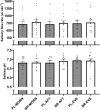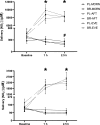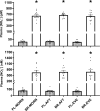Influence of acute dietary nitrate supplementation timing on nitrate metabolism, central and peripheral blood pressure and exercise tolerance in young men
- PMID: 38040982
- PMCID: PMC11055761
- DOI: 10.1007/s00421-023-05369-z
Influence of acute dietary nitrate supplementation timing on nitrate metabolism, central and peripheral blood pressure and exercise tolerance in young men
Abstract
Purpose: Dietary nitrate (NO3-) supplementation can lower systolic blood pressure (SBP) and improve exercise performance. Salivary flow rate (SFR) and pH are key determinants of oral NO3- reduction and purported to peak in the afternoon. We tested the hypotheses that NO3--rich beetroot juice (BR) would increase plasma [nitrite] ([NO2-]), lower SBP and improve exercise performance to a greater extent in the afternoon (AFT) compared to the morning (MORN) and evening (EVE).
Method: Twelve males completed six experimental visits in a repeated-measures, crossover design. NO3--depleted beetroot juice (PL) or BR (~ 13 mmol NO3-) were ingested in the MORN, AFT and EVE. SFR and pH, salivary and plasma [NO3-] and [NO2-], brachial SBP and central SBP were measured pre and post supplementation. A severe-intensity exercise tolerance test was completed to determine cycling time to exhaustion (TTE).
Results: There were no between-condition differences in mean SFR or salivary pH. The elevation in plasma [NO2-] after BR ingestion was not different between BR-MORN, BR-AFT and BR-EVE. Brachial SBP was unchanged following BR supplementation in all conditions. Central SBP was reduced in BR-MORN (- 3 ± 4 mmHg), BR-AFT (- 4 ± 3 mmHg), and BR-EVE (- 2 ± 3 mmHg), with no differences between timepoints. TTE was not different between BR and PL at any timepoint.
Conclusion: Acute BR supplementation was ineffective at improving TTE and brachial SBP and similarly effective at increasing plasma [NO2-] and lowering central SBP across the day, which may have implications for informing NO3- supplementation strategies.
Keywords: Beetroot juice; Cardiovascular health; Circadian rhythms; Exercise performance; Nitric oxide.
© 2023. The Author(s).
Conflict of interest statement
The authors report no conflicts of interest.
Figures




Similar articles
-
Nitrate ingestion blunts the increase in blood pressure during cool air exposure: a double-blind, placebo-controlled, randomized, crossover trial.J Appl Physiol (1985). 2024 Jun 1;136(6):1364-1375. doi: 10.1152/japplphysiol.00593.2023. Epub 2024 Apr 4. J Appl Physiol (1985). 2024. PMID: 38572540 Free PMC article. Clinical Trial.
-
Influence of iodide ingestion on nitrate metabolism and blood pressure following short-term dietary nitrate supplementation in healthy normotensive adults.Nitric Oxide. 2017 Feb 28;63:13-20. doi: 10.1016/j.niox.2016.12.008. Epub 2016 Dec 23. Nitric Oxide. 2017. PMID: 28024935
-
Pharmacokinetics of Nitrate and Nitrite Following Beetroot Juice Drink Consumption.Nutrients. 2021 Jan 20;13(2):281. doi: 10.3390/nu13020281. Nutrients. 2021. PMID: 33498220 Free PMC article. Clinical Trial.
-
Effects of Dietary Nitrate Supplementation on High-Intensity Cycling Sprint Performance in Recreationally Active Adults: A Systematic Review and Meta-Analysis.Nutrients. 2024 Aug 19;16(16):2764. doi: 10.3390/nu16162764. Nutrients. 2024. PMID: 39203900 Free PMC article.
-
Dietary Beetroot Juice - Effects in Patients with COPD: A Review.Int J Chron Obstruct Pulmon Dis. 2024 Jul 29;19:1755-1765. doi: 10.2147/COPD.S473397. eCollection 2024. Int J Chron Obstruct Pulmon Dis. 2024. PMID: 39099609 Free PMC article. Review.
Cited by
-
Nutritional Ergogenic Aids in Cycling: A Systematic Review.Nutrients. 2024 Jun 5;16(11):1768. doi: 10.3390/nu16111768. Nutrients. 2024. PMID: 38892701 Free PMC article.
-
Role of oral and gut microbiomes in enterosalivary nitrate metabolism and their effects on systemic disease.Front Cell Infect Microbiol. 2025 Jul 3;15:1612223. doi: 10.3389/fcimb.2025.1612223. eCollection 2025. Front Cell Infect Microbiol. 2025. PMID: 40677520 Free PMC article. Review.
-
Updates on the Role of Periodontitis-Related Epigenetics, Inflammation, Oral Microbiome, and Treatment in Cardiovascular Risk.J Inflamm Res. 2024 Feb 7;17:837-851. doi: 10.2147/JIR.S449661. eCollection 2024. J Inflamm Res. 2024. PMID: 38344306 Free PMC article. Review.
-
Pilot randomized trial of the effect of antibacterial mouthwash on muscle contractile function in healthy young adults.PLoS One. 2025 Feb 12;20(2):e0312961. doi: 10.1371/journal.pone.0312961. eCollection 2025. PLoS One. 2025. PMID: 39937800 Free PMC article. Clinical Trial.
References
-
- Abu-Alghayth M, Vanhatalo A, Wylie LJ, McDonagh STJ, Thompson C, Kadach S, Kerr P, Smallwood MJ, Jones AM, Winyard PG. S-nitrosothiols, and other products of nitrate metabolism, are increased in multiple human blood compartments following ingestion of beetroot juice. Redox Biol. 2021;43:101974. doi: 10.1016/j.redox.2021.101974. - DOI - PMC - PubMed
Publication types
MeSH terms
Substances
LinkOut - more resources
Full Text Sources
Medical

